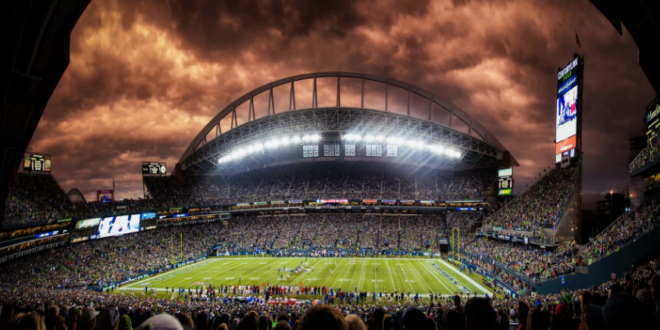A soccer field is typically 100-130 yards long and 50-100 yards wide. The size may vary. Soccer fields come in various dimensions, typically ranging from 100 to 130 yards in length and 50 to 100 yards in width. The International Football Association Board (IFAB) sets guidelines for standard field sizes, but variations exist based on factors such as age group, venue, and competition level.
Understanding the dimensions of a soccer field is crucial for players, coaches, and officials to ensure fair and safe gameplay. We will explore the different sizes of soccer fields and the importance of adhering to these standards. Let’s delve deeper into the world of soccer field dimensions.
How Big is Soccer field

Table of Contents
Dimensions of A Soccer Field
Soccer fields vary in size based on whether they are at a professional level or amateur level. The dimensions of a soccer field play a crucial role in the gameplay, determining the pace and strategy of the match.
Regulation Field Size
Regulation of soccer fields at the professional level must adhere to specific dimensions to ensure fair gameplay. The standard size of a professional soccer field is 100-130 yards in length and 50-100 yards in width. These strict regulations are maintained to standardize the playing surface across competitions.
Variations In Field Sizes
Amateur soccer fields may have varying sizes based on available space and the level of competition. While professional fields must meet exact measurements, amateur fields can range between 50-100 yards in width and 75-130 yards in length. These variations allow for flexibility in organizing matches at different levels.
Layout Of A Soccer Field
The layout of a soccer field is an essential aspect of the game, as it provides a standardized and regulated playing area for teams to compete. The size of a professional soccer field can vary slightly depending on the regulations of the governing body or the specific stadium. However, some common elements are found in the layout of almost every soccer field.
Goal Posts
One of the most prominent features of a soccer field is the goalposts. These are located at each end of the field and are where the players aim to score their goals. The goalposts consist of two upright posts that are connected by a horizontal crossbar. The dimensions of the goalposts can vary, but they are typically around eight feet in height and eight yards in width.
Penalty Areas And Arcs
The penalty areas and arcs are important markings on a soccer field that indicate specific zones with different rules and regulations. The penalty areas are rectangular zones located at each end of the field, in front of the goalposts. These areas are where fouls and offenses committed by the defending team can result in a penalty kick for the opposing team. The penalty areas are typically around 18 yards in length and extend six yards from the goal line.
In addition to the penalty areas, there are also penalty arcs. These are curved lines that extend from the top of each penalty area and form an arc with a radius of 10 yards. The arcs are used to indicate the minimum distance that opposing players must be from the ball during a penalty kick.
Center Circle
The center circle is another important marking on a soccer field. It is located at the midpoint of the field and is used to signify the starting point of the game, as well as restart after a goal is scored. The center circle has a radius of 9.15 meters (10 yards) and is where the ball is placed for the kick-off at the beginning of each half.
Overall, the layout of a soccer field comprises various elements such as goal posts, penalty areas, arcs, and the center circle. These elements provide structure and guidance for players, referees, and spectators, ensuring fair play and an enjoyable game for all involved. Understanding the dimensions and markings of a soccer field is crucial for players and fans alike.
Importance of Field Dimensions
The importance of field dimensions in soccer cannot be overstated. The size of the field directly impacts the gameplay, player strategies, and overall match dynamics. Understanding the significance of field dimensions can shed light on the regulatory standards set for soccer fields. Let’s delve into the impact of field dimensions on gameplay and explore the regulatory standards in place.
Impact on Gameplay
The dimensions of a soccer field play a crucial role in shaping the dynamics of the game. A field that is too small may lead to congestion and limited space for passing and maneuvering, while a field that is too large could result in players being too spread out, affecting team cohesion and strategic play. The size of the field influences player positioning, movement, and tactical strategies, ultimately affecting the flow and intensity of the game.
Regulatory Standards
Regulatory standards for soccer field dimensions are established to ensure consistency and fairness across matches. According to FIFA regulations, the standard dimensions for a soccer field should fall within a range of 100-110 meters in length and 64-75 meters in width for international matches. For domestic and recreational games, the dimensions may vary, but adherence to governing body standards is essential to maintain the integrity of the sport.
Comparison With Other Sports Fields
How big are the soccer field dimensions when compared to other sports fields? Let’s explore the dimensions of the soccer field and compare it with the American football field and rugby pitch.
Football Field (American)
The American football field measures 120 yards in length and 53.3 yards in width, encompassing a total area of 57,600 square yards. In contrast, the soccer field dimensions are between 100-130 yards in length and 50-100 yards in width, resulting in an area of 5,000 to 13,000 square yards. This highlights the significant difference in size between the two fields, with the soccer field being notably larger in area.
Rugby Pitch
When comparing the rugby pitch to the soccer field dimensions, the rugby pitch measures 100 meters in length and 70 meters in width, totaling an area of 7,000 square meters. In comparison, the soccer field’s dimensions are between 100-130 yards in length and 50-100 yards in width, which equates to an area of 5,000 to 13,000 square yards. This demonstrates that the soccer field encompasses a larger playing area than the rugby pitch.

Historical Evolution of Field Size
Soccer, also known as football in many countries, has a long and fascinating history. Over the centuries, the dimensions of soccer fields have undergone significant changes, evolving to suit the various styles of play and growing demands of the game. In this section, we will explore the historical evolution of field size, discussing the origins of field dimensions and the changes that have occurred over time.
Origins Of Field Dimensions
The origins of soccer can be traced back thousands of years to various ancient civilizations, including the Chinese, Greeks, and Romans. However, it was in medieval England that the modern game of soccer began to take shape. During this time, there were no fixed dimensions for soccer fields, and the game was often played in open spaces, meadows, and even village streets.
As the popularity of soccer grew, so did the need for standardized field dimensions. In 1863, the newly formed Football Association in England established the first set of rules for the game, which included guidelines for field size. According to these early regulations, the length of the field should be between 100 and 130 yards (91-119 meters), while the width should be between 50 and 100 yards (46-91 meters).
Changes Over Time
As the game of soccer spread to different parts of the world, the dimensions of soccer fields began to vary. In some countries, the length and width of the field remained relatively consistent with the early English standards. However, in other regions, different dimensions were adopted to accommodate local playing styles and traditions.
Over time, soccer field dimensions continued to evolve. In the 20th century, FIFA, the governing body of international soccer, introduced more standardized regulations for field size. The current FIFA regulations state that the length of a soccer field should be between 100 and 110 yards (90-100 meters), while the width should be between 50 and 70 yards (45-64 meters).
These changes in field size have had a significant impact on the way the game is played. Smaller fields, for example, tend to promote a faster and more compact style of play, while larger fields allow for more open and expansive football.
Overall, the historical evolution of field size in soccer reflects the ever-changing nature of the game. From its humble beginnings on village streets to the standardized regulations of FIFA, the dimensions of soccer fields have adapted to meet the needs and preferences of players and fans around the world.
Challenges In Maintaining Field Size
Managing the vast expanse of football field dimensions presents significant challenges, particularly in ensuring proper maintenance and upkeep.
Natural Turf Vs. Artificial Turf
Natural Turf: Requires regular watering, mowing, and fertilizing to keep the field playable and safe for athletes.
Artificial Turf: Involves periodic grooming, infill replenishment, and repair of worn-out sections for longevity.
Climate And Location Factors
- High Temperatures: Accelerate grass growth, necessitating frequent mowing and watering.
- Heavy Rainfall: Leads to waterlogged fields, requiring drainage systems to prevent flooding.
- Extreme Cold: Demands special care to prevent turf damage and ensure playability.
Future Trends In Soccer Field Design
Soccer field design is constantly evolving with the integration of advanced technology and sustainable measures. These future trends are essential in enhancing the playing experience, improving safety, and reducing environmental impact.
Technology Integration
The incorporation of technology in soccer field design is revolutionizing the way the game is played and experienced. Advanced turf management systems utilizing GPS and sensors provide real-time data on player movements and field conditions. This data helps in optimizing maintenance practices and enhancing player performance. Additionally, innovations in stadium technology, such as augmented reality for interactive fan experiences, are shaping the future of soccer field design.
Sustainability Measures
Sustainability is a key focus in the evolution of soccer field design. The use of eco-friendly materials in turf and stadium construction, along with water-efficient irrigation systems, helps reduce the environmental impact of soccer fields. Furthermore, the integration of renewable energy sources, such as solar panels, contributes to the sustainability of soccer field operations.

Impact of Field Size on Player Performance
The impact of field size on player performance in soccer is a crucial factor to consider. The size of a soccer field can vary, but it typically ranges between 100-130 yards long and 50-100 yards wide. The dimensions of the field can affect the dynamics of the game, player positioning, and overall strategy.
Strategic Considerations
The size of a soccer field plays a crucial role in determining the strategic considerations of the game. On a large field, players have to cover more ground, which can lead to a more open style of play. This can require different tactical approaches compared to a smaller field, where defenders can close down space more effectively.
With more space to cover, teams may opt for a formation that emphasizes mobility and possession to exploit the expansiveness of the field. Conversely, on a smaller field, a compact defensive setup and quick transitions may be more effective for controlling the game.
Fitness and Endurance
The size of the soccer field directly impacts the fitness and endurance levels required of players. On a larger field, players need to have superior physical conditioning to maintain high-intensity performances for longer durations. Covering more ground and constantly transitioning between attack and defense demands exceptional stamina and endurance.
Conversely, on a smaller field, quick bursts of speed and agility may take precedence over sustained endurance. This can result in a different focus on fitness training and player selection based on the specific demands of the field size.
Conclusion
Understanding the size of a soccer field is essential for players, coaches, and fans alike. The dimensions of a soccer field are standardized, with variations based on age groups. From professional to youth games, knowing the exact measurements helps ensure fair play and accurate field positioning.
So, whether you’re planning a game or simply curious, knowing how big a soccer field is will enhance your understanding and appreciation of the beautiful game.
 SMGB TODAY Sports, Movies, TV Shows
SMGB TODAY Sports, Movies, TV Shows

